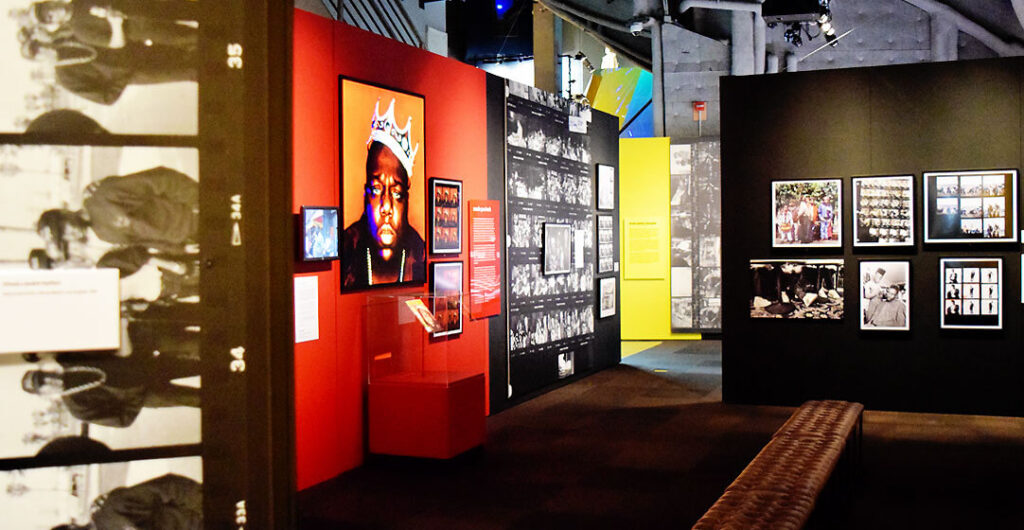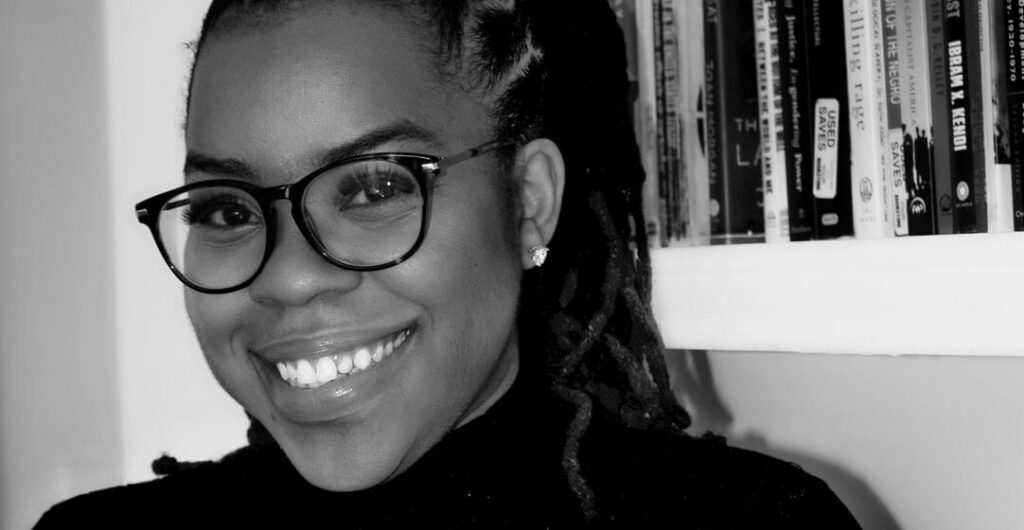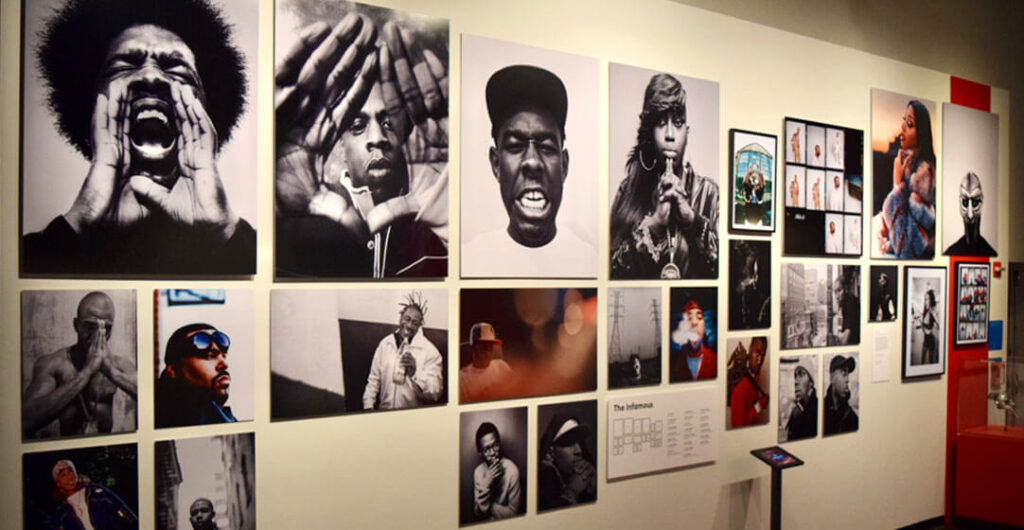Salt-N-Pepa, Notorious B.I.G, Tupak Shakur and more are featured in hip-hop retrospective
It has been said that hip-hop was born on a hot summer night in New York City’s west Bronx on Aug. 11, 1973, when 18-year-old Jamaican-American Clive Campbell, known as DJ Kool Herc, and his sister, Cindy, put on a back-to-school jam in the Rec room of an apartment block at 1520 Sedgewick Ave.
DJ Kool Herc had been experimenting with a “break-beat” style, switching between identical records on two turntables. He noticed at parties that people were waiting for the drum beat and rhythm sections of a record, known as a “break-beat.” So, he’d been refining a technique of looping the short drum breaks on the record into an extended beat. On this night, so the story goes, invitations were sent out around the neighborhood on index cards, admission price of 25 cents for women and 50 cents for men. At around 9 p.m., the first people started to show up, what would become a crowd of around 200.
And the rest, as they say, is history.

In recognition of the lasting power and huge cultural impact of hip-hop on music, fashion, style, graffiti art, poetry, even politics, Seattle’s Museum of Pop Culture (MoPOP) has opened the year-long exhibit, “Contact High: A Visual History of Hip-Hop.” Some 170 images chart the history of the genre from the 1970s through the early 2000s. You will see iconic images of hip-hop’s most influential artists, such as Missy Elliott, Jay-Z, Queen Latifah and Tupac Shakur, as well as contact sheets that reveal the creative process of a photo session.
In addition, MoPOP’s permanent collection of hip-hop artifacts includes, among many other objects, early rap battle fliers, Tupac Shakur manuscripts, Flavor magazines and costumes from Sha-Rock, The Notorious B.I.G. and Grandmaster Flash Turntables.
“Our permanent collection of hip-hop artifacts is pretty extensive,” said Adeerya Johnson, MoPOP’s digital collections archivist and a hip-hop scholar during an interview in January. Johnson says MoPOP is also compiling and documenting its collection online.
“In house, we have a little more than 2,000 artifacts, but 1,300 of those and, in time, more, will be online for people to see,” she said. “So outside of those photos, you can see these physical items that have built up this culture.”
Johnson spoke more with us about the exhibition and the history of hip-hop.

What can people expect to see with the exhibition?
The exhibit was originally a book by Vikki Tobak that was a collection of early hip-hop photos, contact sheets, different background shots of hip-hop artists, music albums and things like that. So, it is those early images that you see before they go in print or on a cover of an album.
As you go through the exhibit, you kind of go through the early years of hip-hop from the early 1980s; you travel through the 90s and the early 2000s. You see how the photos are selected and chosen from these contact sheets. You will see some of the markings and things like that. It kind of shows how folks were using photography before we had social media, how these celebrities and artists would go to photographers to create these dynamic shots.
Throughout the museum you will see contact sheets and different photos, a few Polaroids. Also, a lot of it is paired with our own artifacts. We are so grateful that the Rock & Roll Hall of Fame donated their Rakim jacket designed by Dapper Dan, and we also have the MF Doom mask that was also given to us for the exhibit. The exhibit has a lot of pieces that highlight how Hip Hop was documented behind the lens.

Why is hip-hop important as an art form?
This year in August it will be the 50th anniversary of hip-hop, and so that speaks to the legacy in which this culture was created. Hip-hop was originally created by Black and Latino youth in the Bronx, Black and Latino youth in LA and, of course, Black youth in the South. The uniqueness of the genre is that it was created by kids. The fact that these kids are creating a culture that includes dancing, Djing, graffiti art, rapping, poetry—all of these senses come back to their living conditions.
If you are looking at the early years of hip-hop it is how can these children finally escape from their living experiences, right? It is how they are escaping from violence in their community, how they are escaping drug abuse in their community, and also just the environmental factors of being Black and Latino in New York with the police brutality and the violence.
So, it is important to understand that hip-hop is one of those genres that actually highlights how people of color turned their environment into a space for enjoyment, because this is not a genre that is coming from upper class families. These are your low-income, working class kids that are expressing themselves in the harsh environment that they live in, and you can hear that in their music, and you can see that in how the styles are curated and how the music sounds and their stories are told. So, I think that is the most important thing about learning about hip-hop.

Hip-hop may be the most popular musical genre around. Is it still evolving?
There are a lot of ways you can look at the evolution of hip-hop. One of the ways is how the production has changed and the emergence of Southern hip-hop, even with that coming in the early 90s. This new wave of artists is producing sounds, and their music is a little bit different. Of course, there is always fashion. Fashion has always been a major cornerstone. Fashion and hip-hop has changed, and we can look at how urban communities and black folks express themselves through fashion and style.
And, ultimately, we are in a very unique era for how we are talking about women in hip-hop. I say that because, while women have always been a part of hip-hop since the very beginning, hip-hop has been seen as a male-dominated industry, and all the leaders and the founders and cultivators have always been known as men. But now we see a lot of these originators of hip-hop giving props and letting folks know that there are a lot of women that have always been part of hip-hop.
We have a really great lineup of a lot of women artists that we just didn’t see en masse in the early years in the early 80s and 90s. And folks are documenting how women of hip-hop are being helpful, how they have developed their careers. So, I really do feel that evolution is realizing that hip-hop is more than just what the men have to contribute to this culture, but also what women have as well.

What do you hope that people learn from the exhibition?
I want people to learn that hip-hop is dynamic and that it is not a monolith. One of the major perceptions about hip-hop when it was starting is that it was this young, really rough, hard-to-understand genre that didn’t have any longevity; and I feel like when people engage with the exhibit, and also our online collection that comes out in March, that, historically, hip-hop has beat that.
It has gone against the odds of what people said about how long hip-hop was going to last. A large part of that is the uniqueness of hip-hop. It is not just people rapping on a microphone or DJs spinning on vinyl, its an entire culture of people, it’s the fashion, it’s clothing, it’s how personalities and icons are created because of their roots to this music. It’s how the music makes them feel.
You kind of see the expression of that in these photos. You see a little bit of pain. You see a lot of joy, a lot of edge. You see a lot of different expressions in these photos. And the people who have built this genre put in a lot of work, a lot of blood, sweat and tears, and I think that is why we see that longevity of hip-hop and why it has lasted for 50 years.
“Contact High: A Visual History of Hip-Hop” runs through 2023. MoPOP is open 10 a.m. to 5 p.m. daily except Wednesdays. The regular admission price varies by the day from $25 to $30.25. Discounts are available on the plan-ahead ticket price for youth, seniors, students and the military.
Bonus: February is Seattle Museum month. Stay in one of 70 Seattle hotels during the month of February and get half-price admission to several area museums and attractions (including MoPop). Participating hotels include AAA Washington discount partners Best Western, Hilton and Hyatt hotels, among many others. Find the full list of AAA Washington discounts here.

Road Trip Tips
Before you go: Get ready for your road trip with a AAA Membership. Get peace-of-mind on the road plus travel and insurance services and much more.
Save on hotels and rental cars: Unlock savings on hotels with a AAA membership. Plus, AAA members save up to 20% with Hertz.
Save on car insurance: AAA members save up to 8% on car insurance.
Get battery service: AAA Mobile Battery Service uses state-of-the-art technology to accurately diagnose battery-related problems. We’ll even replace your battery with a brand-new one if necessary, at a special member price.
Save with AAA member discounts: AAA membership gives you access to exclusive entertainment discounts nationwide.
—Written by Victor Whitman
—Top photo: MoPop









